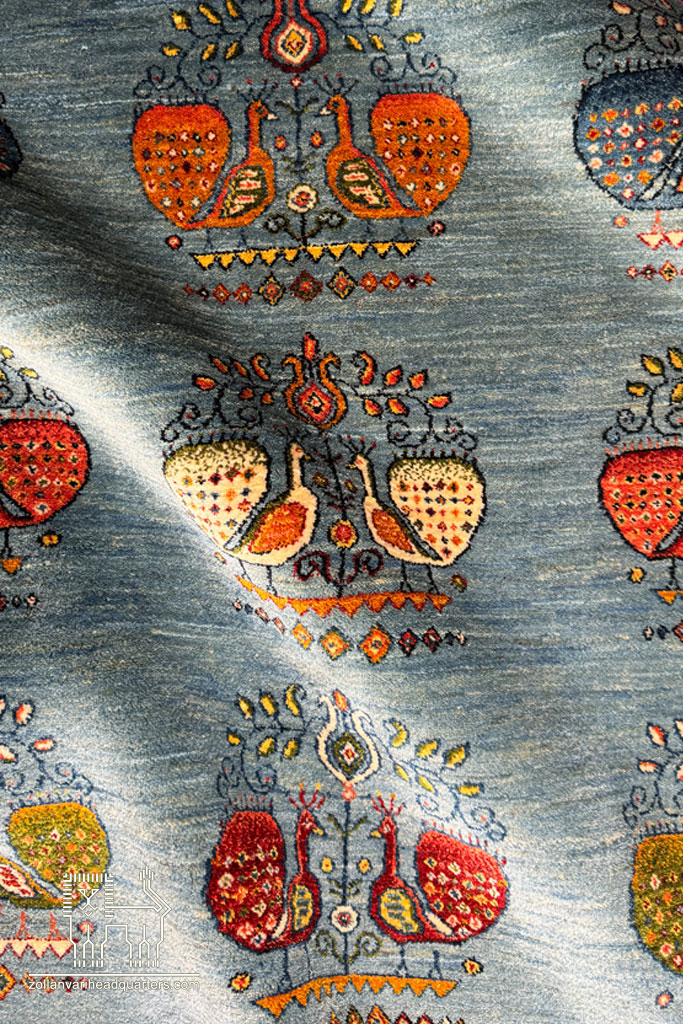Difference Between Wool and Fluff in Carpet Weaving
The art of carpet weaving is considered one of the most beautiful and important handicrafts in Iran, always recognized as a symbol of Iranian authenticity and culture worldwide. In Iranian handwoven carpets, the choice of raw materials plays a significant role in their quality and durability. The two main and widely used materials in Iranian carpet weaving are wool and fluff. Although these two materials have similarities in appearance, they differ greatly in structure, properties, and usage in carpet weaving. This content will examine the differences between wool and fluff in carpet weaving in more detail and provide tips for purchasing original carpets. We will also refer to the works of Master Zollanvari, who has created his artistic works using natural materials and high-quality weavings.
Wool in Carpet Weaving: A Miracle of Nature
Wool is a natural and highly durable material widely used in carpet weaving. Sheep wool, due to its specific physical and chemical structure, is recognized as a material with unique properties. This material has the ability to resist high moisture levels and is highly resistant to pressure and wear. Additionally, wool acts as a natural heat regulator. This means that wool carpets naturally retain heat and transfer more warmth to the space during cold seasons.
One of the interesting features of wool is its soothing property. For example, the use of wool carpets, due to their calming effects, can help improve blood circulation in the limbs and skin. This feature is especially important in therapeutic and health-related contexts. In addition to its physical properties, wool has high dyeing potential and can be found in a wide range of colors.
Wool, as a natural material, also improves sleep and enhances the quality of rest. These properties make wool widely used in various industries such as textiles, carpet weaving, and the production of high-quality carpets.
Fluff in Carpet Weaving: Softness and Delicacy
Unlike wool, fluff is a delicate and thin material mostly used in the weaving of fine fabrics and clothing. Fluff is made from very fine and thin fibers, typically harvested from the skin of animals such as camels, goats, and some other mammals. For example, Kashmir fluff is a premium type of these fibers, used in the weaving of luxury fabrics and expensive clothing.
In contrast to wool, which is highly resistant to moisture, fluff becomes vulnerable in humid conditions. Also, fluff does not perform as well in terms of strength as wool, which is why it is less commonly used in the production of high-quality carpets. However, due to its softness and delicacy, carpets woven with fluff, especially in specific regions like mountainous and cold areas, are highly popular.
Differences Between Wool and Fluff in Carpet Weaving
In summary, the main differences between wool and fluff in carpet weaving are as follows:
- Strength and Durability: Wool, due to its high resistance to moisture and wear, is used in the weaving of high-quality carpets. On the other hand, fluff is used less frequently in carpets due to its delicacy and softness.
- Thermal Properties: Wool has temperature-regulating properties and transfers more heat to the space in winter, whereas fluff lacks this feature.
- Soothing Properties: Wool has natural soothing effects on the body and helps improve blood circulation, whereas fluff does not have these properties.
- Dyeing Ability: Wool has a high capacity to absorb a wide range of natural colors, while fluff has limited dyeing capabilities due to its delicate structure.
- Use in Carpets: Wool is used in the weaving of high-quality carpets and rugs, while fluff is more commonly used in the production of fine fabrics and clothing.

The Influence of Master Zollanvari in Carpet Weaving Art
Master Zollanvari, one of the greatest artists in the field of carpet and rug weaving in Iran, has been able to create remarkable works using the finest raw materials and his unique techniques. By carefully selecting high-quality wool and fluff and employing special methods in weaving, he has produced carpets of very high quality and beautiful appearance, earning the admiration of art critics. Zollanvari’s works are a true representation of the fusion of Iranian art and authenticity, created using natural and high-quality materials, especially wool and fluff.
Conclusion
When purchasing a carpet, the choice between wool and fluff depends on individual needs and preferences. Wool, with features such as high durability, soothing properties, and wide dyeing ability, is the best choice for high-quality carpets. In contrast, fluff, with its softness and delicacy, is more commonly used in the production of luxury fabrics and light rugs. Works created by Master Zollanvari are an example of the correct and artistic use of these two natural materials in carpet weaving, and therefore can serve as a good model for those interested in the art of carpet weaving.
